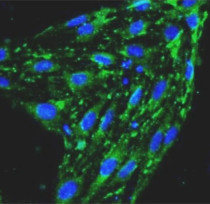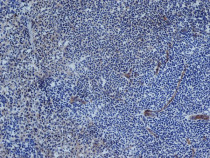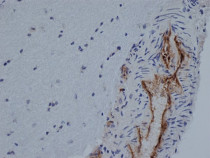ARG22919
anti-CD31 antibody [TLD-3A12]
anti-CD31 antibody [TLD-3A12] for ELISA,Flow cytometry,ICC/IF,IHC-Frozen sections,Western blot and Rat,Pig,Rhesus Monkey
Cancer antibody; Cell Biology and Cellular Response antibody; Controls and Markers antibody; Developmental Biology antibody; Signaling Transduction antibody; Endothelial Cell Marker antibody; Microvascular Density Study antibody
Overview
| Product Description | Mouse Monoclonal antibody [TLD-3A12] recognizes CD31 Mouse anti Rat CD31 antibody, clone TLD-3A12 recognizes rat PECAM-1 (CD31), a 661 amino acid type 1 transmembrane protein expressed primarily on endothelial cells, platelets and leucocytes.Clone TLD-3A12 has been shown to partially block the proliferative response of antigen-specific CD4+ T cells to antigen-presenting cells and relevant antigen (Stevenson, K.S. et al.2009). This clone has been reported as suitable for use in IHC on formalin-fixed paraffin-embedded sections pre-treated with 0.2M boric acid, pH7.0. (Wilson et al. 2007). Mouse anti Rat CD31, clone TLD-3A12 has been shown to be cross-reactive with endothelial cells derived from rhesus macaque (Maclean et al. 2001) |
|---|---|
| Tested Reactivity | Rat, Pig, R. Mk |
| Tested Application | ELISA, FACS, ICC/IF, IHC-Fr, WB |
| Host | Mouse |
| Clonality | Monoclonal |
| Clone | TLD-3A12 |
| Isotype | IgG1 |
| Target Name | CD31 |
| Antigen Species | Rat |
| Immunogen | Activated, Lewis Rat derived microglial cells. |
| Conjugation | Un-conjugated |
| Alternate Names | EndoCAM; CD31/EndoCAM; PECAM-1; CD31; PECA1; CD antigen CD31; GPIIA'; endoCAM; Platelet endothelial cell adhesion molecule |
Application Instructions
| Application Suggestion |
|
||||||||||||
|---|---|---|---|---|---|---|---|---|---|---|---|---|---|
| Application Note | FACS: Use 10 µl of the suggested working dilution to label 10^6 cells in 100 µl. * The dilutions indicate recommended starting dilutions and the optimal dilutions or concentrations should be determined by the scientist. |
Properties
| Form | Liquid |
|---|---|
| Purification | Purification with Protein A. |
| Buffer | PBS and 0.09% Sodium azide |
| Preservative | 0.09% Sodium azide |
| Concentration | 1 mg/ml |
| Storage Instruction | For continuous use, store undiluted antibody at 2-8°C for up to a week. For long-term storage, aliquot and store at -20°C or below. Storage in frost free freezers is not recommended. Avoid repeated freeze/thaw cycles. Suggest spin the vial prior to opening. The antibody solution should be gently mixed before use. |
| Note | For laboratory research only, not for drug, diagnostic or other use. |
Bioinformation
| Database Links |
Swiss-port # Q3SWT0 Rat Platelet endothelial cell adhesion molecule Swiss-port # Q95242 Pig Platelet endothelial cell adhesion molecule |
|---|---|
| Gene Symbol | Pecam1 |
| Gene Full Name | platelet/endothelial cell adhesion molecule 1 |
| Background | CD31 protein is found on the surface of platelets, monocytes, neutrophils, and some types of T-cells, and makes up a large portion of endothelial cell intercellular junctions. The encoded protein is a member of the immunoglobulin superfamily and is likely involved in leukocyte migration, angiogenesis, and integrin activation. [provided by RefSeq, May 2010] |
| Function | CD31 is a cell adhesion molecule which is required for leukocyte transendothelial migration (TEM) under most inflammatory conditions (PubMed:19342684, PubMed:17580308). Tyr-690 plays a critical role in TEM and is required for efficient trafficking of PECAM1 to and from the lateral border recycling compartment (LBRC) and is also essential for the LBRC membrane to be targeted around migrating leukocytes (PubMed:19342684). Trans-homophilic interaction may play a role in endothelial cell-cell adhesion via cell junctions (PubMed:27958302). Heterophilic interaction with CD177 plays a role in transendothelial migration of neutrophils (PubMed:17580308). Homophilic ligation of PECAM1 prevents macrophage-mediated phagocytosis of neighboring viable leukocytes by transmitting a detachment signal (PubMed:12110892). Promotes macrophage-mediated phagocytosis of apoptotic leukocytes by tethering them to the phagocytic cells; PECAM1-mediated detachment signal appears to be disabled in apoptotic leukocytes (PubMed:12110892). Modulates bradykinin receptor BDKRB2 activation (PubMed:18672896). Regulates bradykinin- and hyperosmotic shock-induced ERK1/2 activation in endothelial cells (PubMed:18672896). Induces susceptibility to atherosclerosis. Isoform Delta15: Does not protect against apoptosis. [UniProt] |
| Research Area | Cancer antibody; Cell Biology and Cellular Response antibody; Controls and Markers antibody; Developmental Biology antibody; Signaling Transduction antibody; Endothelial Cell Marker antibody; Microvascular Density Study antibody |
| Calculated MW | 83 kDa |
| PTM | Phosphorylated on Ser and Tyr residues after cellular activation. Phosphorylated on tyrosine residues by FER and FES in response to FCER1 activation (By similarity). In endothelial cells Fyn mediates mechanical-force (stretch or pull) induced tyrosine phosphorylation. Palmitoylation by ZDHHC21 is necessary for cell surface expression in endothelial cells and enrichment in membrane rafts. |
Images (3) Click the Picture to Zoom In
-
ARG22919 anti-CD31 antibody [TLD-3A12] ICC/IF image
Immunofluorescence: Rat BM-ECFCs stained with ARG22919 anti-CD31 antibody [TLD-3A12] at 1:100 dilution.
-
ARG22919 anti-CD31 antibody [TLD-3A12] IHC-Fr image
Immunohistochemistry: Rat spleen cryosection stained with ARG22919 anti-CD31 antibody [TLD-3A12].
-
ARG22919 anti-CD31 antibody [TLD-3A12] IHC-Fr image
Immunohistochemistry: Rat brain cryosection stained with ARG22919 anti-CD31 antibody [TLD-3A12].








